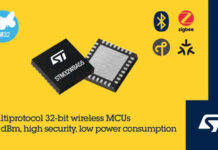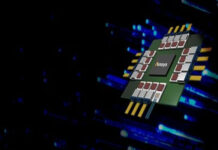Bangalore— AMD has announced a strategic collaboration with ECARX, a global mobility tech company. The companies will work together on an in-vehicle computing platform for next-generation electric vehicles (EVs), expected to be in mass production for global rollout in late 2023. The ECARX digital cockpit will be the first in-vehicle platform to be offered with AMD Ryzen Embedded V2000 processors and AMD Radeon RX 6000 Series GPUs along with ECARX hardware and software.
Combining the extensive experience in automotive digital cockpit design of ECARX with AMD advanced computing power and stunning visual graphic rendering capabilities, the companies aim to deliver an innovative in-car experience. The digital cockpit will launch with advanced features including driver information mode, heads-up display, rear seat entertainment, multiple-displays, multi-zone voice recognition, high-end gaming and a full 3D user experience.
“As car companies seek to deliver immersive experiences and intelligent features for their next-generation electric vehicles, the AMD-powered ECARX digital cockpit will address these needs for the global automotive market,” said Rajneesh Gaur, corporate vice president and general manager, Embedded Business, AMD. “We are excited to work with ECARX as our first strategic ecosystem partner in China for the digital cockpit using our Ryzen Embedded V2000 processers and Radeon RX 6000 Series GPUs.”
“The global automotive industry is transforming towards an intelligent future at an unprecedented pace with demand for computing power and graphics capabilities rapidly increasing,” said Ziyu Shen, Chairman and CEO of ECARX. “With this collaboration, we will further enable OEMs and tier 1 suppliers to enhance their digital cockpit experiences as they seek to create greater consumer value through intelligent connected cars.”
The automotive EV market, as well as the technology required to support it, represents an unprecedented growth opportunity in the years ahead according to analyst firm, Strategy Analytics. “EV adoption is now a key underlying factor for growth in the automotive semiconductor market and the associated semiconductor demand is forecast to grow at a CAAGR of 31% over 2021 – 2026,” said Asif Anwar, executive director – PBCS and EVS, Strategy Analytics. “The EV revolution is here, with next-generation EV platforms at the leading edge of domain- and zonal-based architecture driving adoption of the digital cockpit, ADAS and the connected vehicle.”
About AMD Ryzen Embedded V2000 Processors
The Ryzen Embedded V2000 Series processors are the second generation designed for automotive in-vehicle infotainment and instrumentation applications, plus additional applications such as industrial edge, thin client, and miniPC systems. For customers and applications that need high-performance display capabilities, the Ryzen Embedded V2000 Series processors can power up to four independent displays simultaneously in 4K resolution as it is equipped with up to eight CPU cores and seven GPU compute units. A single AMD Ryzen Embedded V2000 Series processor provides up to 2x[i] the multi-threaded performance-per-watt, up to 30 percent[ii] better single-thread CPU performance and up to 40 percent[iii] better graphics performance over the previous generation.
About AMD Radeon RX 6000 Series GPUs AMD Radeon RX 6000 Series GPUs are built upon the breakthrough AMD RDNA™ 2 graphics architecture, the only graphics architecture that spans from next-generation desktop PCs, laptops and consoles to mobile devices and automotive infotainment systems. Engineered from the ground up for superior performance and power efficiency, AMD RDNA 2 architecture offers up to 2X higher performance[iv] and up to 50 percent more performance-per-watt[v] in select titles compared to the previous-generation AMD RDNA architecture.
[i] Testing conducted by AMD Performance Labs as of July 2020 on the Ryzen™ Embedded V2718 and June 2018 on the Ryzen Embedded V1605B processor both at 15 watts (STAPM mode enabled) using Cinebench R15 nt. Results may vary. EMB-169
[ii] Testing conducted by AMD Performance Labs as of July 2020 on the Ryzen™ Embedded V2718 and June 2018 on the Ryzen Embedded V1605B processor both at 15 watts (STAPM mode enabled) using Cinebench R15 1T. Results may vary. EMB-171
[iii] Testing conducted by AMD Performance Labs as of July 2020 on the Ryzen™ Embedded V2718 and June 2018 on the Ryzen Embedded V1605B processor both at 15 watts (STAPM mode enabled) using 3DMark11. Results may vary. EMB-172
[iv] Testing done by AMD performance labs October 20 2020 on RX 6900 XT and RX 5700 XT (20.45-201013n driver), AMD Ryzen 9 5900X (3.70GHz) CPU, 16GB DDR4-3200MHz, Engineering AM4 motherboard, Win10 Pro 64. The following games were tested at 4k at max settings: Battlefield V DX11, Doom Eternal Vulkan, Forza DX12, Resident Evil 3 DX11, Shadow of the Tomb Raider DX12. Laptop manufacturers may vary configurations, yielding different results.Performance may vary.
[v] Testing done by AMD performance labs 10/16/20, using Assassins Creed Odyssey (DX11, Ultra), Battlefield V (DX12, Ultra), Borderlands 3 (DX12, Ultra), Control (DX12, High), Death Stranding (DX12 Ultra), Division 2 (DX12, Ultra), F1 2020 (DX12, Ultra), Far Cry 5 (DX11, Ultra), Gears of War 5 (DX12, Ultra), Hitman 2 (DX12, Ultra), Horizon Zero Dawn (DX12, Ultra), Metro Exodus (DX12, Ultra), Resident Evil 3 (DX12, Ultra), Shadow of the Tomb Raider (DX12, Highest), Strange Brigade (DX12, Ultra), Total War Three Kingdoms (DX11, Ultra), Witcher 3 (DX11, Ultra no HairWorks) at 4K. System comprised of a Radeon RX 6800 XT GPU with AMD Radeon Graphics driver 27.20.12031.1000 and an Radeon RX 5700 XT GPU with AMD Radeon Graphics driver 26.20.13001.9005, Intel Core i9-9900K (3600 MHz 8C/16T), 32 GB at 2133 MHz, ROG MAXIMUS XI HERO (WI-FI) motherboard. Laptop manufacturers may vary configurations, yielding different results. Performance may vary. RX-549















